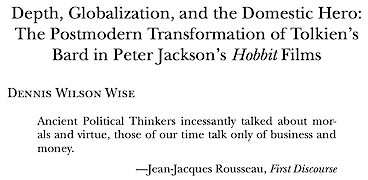
Depth, globalization, and the domestic hero: The postmodern transformation of Tolkien’s Bard in Peter Jackson’s Hobbit films
5 October 2021 | Tolkien Studies, XVIII, 211
… At one point in The Battle of the Five Armies (2014), the third installment of Peter Jackson’s Hobbit film trilogy, the sycophantic Alfrid Lickspittle asks Bard the Bowman, “The Master’s mantle was there for the taking, but you threw it all away. And for what?” Although Bard declines to respond, the camera pans quickly to Bard’s children. The implication is clear: more than political influence, money, or power, what matters is family. As far as subtlety goes, Jackson will win few prizes. Still, that single pan shot deftly pinpoints a key issue with his adaptation of The Hobbit. Much like Tolkien himself, Jackson criticizes personal greed in his films, or at least a cartoonish version of greed, but he inserts a theme of family values wholly absent from Tolkien’s original tale. One need not look far for an explanation. As film scholar Kristin Thompson explains, most of “the highest-grossing films of recent decades are aimed at both adults and children” (74). Given the vast expense of modern blockbusters, Jackson evidently felt the need to make his films reach as wide an audience as possible. Since a family film should depict actual families, however, Jackson chose to transform the grim-faced, grim-voiced Bard, a man with no family cited within the original text, into a sympathetic widower with two daughters (invented) and a son, Bain, whom Tolkien only devised several years after originally publishing The Hobbit.…
❧